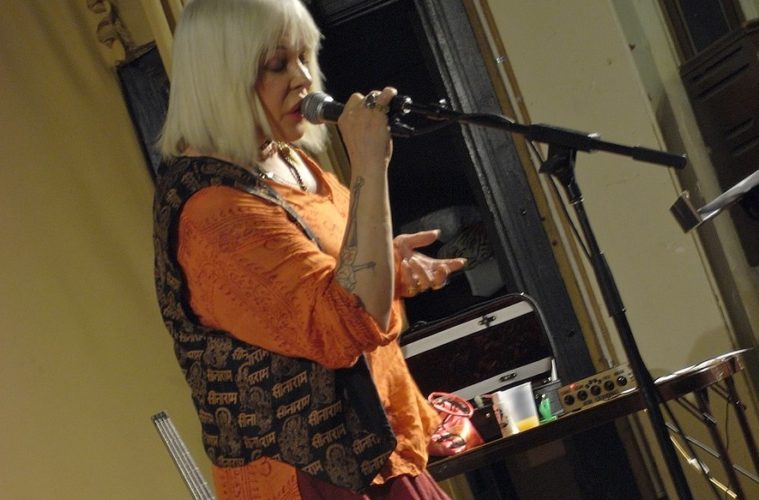There is precious little in this world that is truly original. But British performance artist, author and musician Genesis Breyer P-Orridge, who died March 14 at the age of 70, was a veritable personal and artistic visionary, provocateur and iconoclast. Musically best-known for forming both pioneering industrial band Throbbing Gristle in 1975 and the slightly more accessible art-video rock lineup Psychic TV in 1982, P-Orridge’s prolificacy was matched only by their creativity.
(P-Orridge, who began referring to themself as “we” in 2007 in homage to late wife Lady Jaye, began the personal Pandrogeny Project with Lady Jaye in 1995, an attempt to unite as a “pandrogyne,” or single entity, via numerous surgeries to mirror each other’s appearance, including matching breast implants.)
Leaving behind a massive, cross-media legacy and proving hugely influential on artists including Nine Inch Nails, Laura Jane Grace and Skinny Puppy, ultimately, what comes through most powerfully in writings and interviews is P-Orridge’s humanity and creativity, both seemingly unbounded. Pushing the envelope on numerous art forms and “normal” society was a life-long pursuit that was nearly in full swing by the time they were in their mid-teens. Experiments in counterculture and gender norms began early, after finding many at their all-boys school “vile, vicious and aggressive.” In 1967, at 17, P-Orridge, who preferred gender-neutral pronouns, founded their first collective, Worm, inspired by John Cage and made up of school friends.
More influential was COUM Transmissions, their subversive Dada and Surrealist-influenced art and music collective that flourished from 1969 to 1976. P-Orridge, in every endeavor, employed the theory of “cutups,” a literary device used by friend William Burroughs that P-Orridge applied to everyday life. The approach was to question the order of everything; rearrange, disrupt and cut-up to see what emerges. It was that impetus from whence Throbbing Gristle emerged, P-Orridge saying in one interview that “everybody is capable of music, whether they realize it or not.”
That supposition went further; a la Cage, anything that makes noise is music. The result? The not-so-arguably first industrial band, Throbbing Gristle (Brit slang for a penis), who put out nine studio albums and numerous compilations and cassettes on their own Industrial Records. Thanks to TG and songs like the ominously creepy thrum of “Hamburger Lady” and the spooky, spare 20 Jazz Funk Greats, P-Orridge was aptly coined the God-Parent of Industrial.
Their subsequent band, Psychic TV, where they presented in more of a chanteuse style, lasted until P-Orridge’s death, leaving behind a discography of, apparently, 100 full-length albums, over 15 compilation albums and more than 30 singles and EPs. A group/movement emerged at the same time the band formed: Thee Temple ov Psychick Youth (a.k.a. T.O.P.Y.) was created as a magical order and the philosophical wing the band, and it produced the revered tome THEE PSYCHICK BIBLE: Thee Apocryphal Scriptures ov Genesis Breyer P-Orridge and Thee Third Mind ov Thee Temple ov Psychick Youth.
Concepts and ideas that spawned “creative novelty and surprise” were a way of life. The acceptance of flux, along with constant self-analysis in order to “break every routine” to achieve newness are among the most enduring and inspiring concepts they followed and fomented. One must be, P-Orridge said, “ex-dream,” in other words — awake — to create and live fully. While it is tempting to rest on laurels in middle and old age, P-Orridge retained the experimentation of youth combined with wisdom, weirdness and wonder gleaned from the ages. It’s a state of being that inspired many they came in contact with.
For many kids — whether in 1975 or 2020 — whose left-of-center curiosity led down the rabbit hole of Alister Crowley, or to RE/Search publications; or who wanted to join the Jim Rose Sideshow Circus, P-Orridge is an icon, though not one without controversy. As the title of a Guardian article questioned, “Genesis P-Orridge: fantastic transgressor or sadistic aggressor?” The article was spawned by revelations in the 2017 autobiography Art Sex Music from avant-garde performer Cosey Fanni Tutti. She was in Throbbing Gristle, and also was P-Orridge’s romantic partner. In the book, she details physical, emotional and sexual abuse she says she endured from P-Orridge during that time, which P-Orridge refuted. It was not their first encounter with abuse charges: During the ‘90s “Satanic Panic,” a U.K. documentary accused P-Orridge of sexually abusing children. P-Orridge was cleared of all charges, though it caused them to permanently leave the United Kingdom to settle in the U.S. in 1995.
The final Instagram post from P-Orridge, under their user name pandrogyne, was a close-range, makeup-free selfie captioned: “this is me today waiting to go home.” They meant, per an earlier post, home from the “HorsePistol” after being treated for fluid on the lungs, but after their passing, it took on a more mystical meaning. In a 2014 interview, they discussed the quest for divinity: “In alchemy, the divine hermaphrodite is a powerful symbol, and when you look at the story of creation, Adam and Eve come from one body, and then become two. Maybe the whole point is to eventually reunify with our divine self.” If so, P-Orridge, a GodStar as eloquently elucidated in a Psychic TV song, is one with all; a transcendent being who transcended their earthly trappings.
Advertising disclosure: We may receive compensation for some of the links in our stories. Thank you for supporting LA Weekly and our advertisers.

